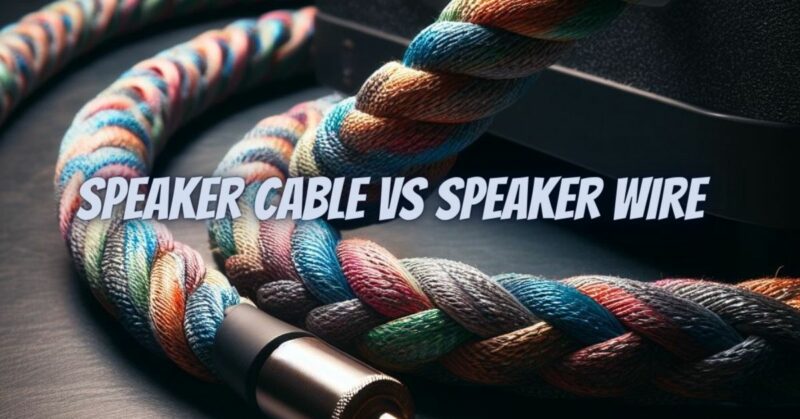The choice between speaker cable and speaker wire is a fundamental consideration in setting up your audio system. Both serve the essential purpose of transmitting audio signals from your amplifier or receiver to your speakers, but they differ in construction, design, and performance characteristics. In this comprehensive article, we will explore the distinctions between speaker cable and speaker wire, helping you make an informed decision based on your specific audio needs and preferences.
Speaker Cable
Speaker cable is a type of electrical cable designed explicitly for audio applications. It typically consists of multiple conductors insulated within a single jacket. Speaker cables are available in various configurations, including different conductor materials, gauges, and terminations.
Speaker Wire
Speaker wire, on the other hand, is a simpler form of cable primarily composed of two conductors (positive and negative) insulated individually or together. Speaker wire is often used for basic audio setups and is available in various gauges and materials.
Now, let’s delve into a detailed comparison of speaker cable and speaker wire across multiple aspects:
1. Construction:
- Speaker Cable: Speaker cables typically have more complex constructions, with multiple insulated conductors within a single outer jacket. This design can improve signal separation and reduce interference, enhancing audio quality.
- Speaker Wire: Speaker wire is simpler, consisting of two conductors. While it’s more basic in design, it can still transmit audio signals effectively, especially in less demanding setups.
2. Conductors:
- Speaker Cable: Speaker cables may feature multiple conductors per cable, allowing for bi-wiring or bi-amplification setups. The conductors can be made from various materials, including copper, silver, or other alloys.
- Speaker Wire: Speaker wire typically consists of two conductors, often made from copper. The gauge (thickness) of the wire can vary, affecting its resistance and performance.
3. Gauge:
- Speaker Cable: Speaker cables come in various gauges, from thin to thick. Thicker cables generally have lower resistance and can transmit signals over longer distances with less signal loss.
- Speaker Wire: Speaker wire gauge is a critical consideration. Thicker wire (lower gauge) offers lower resistance and can handle more power, making it suitable for high-power systems.
4. Signal Quality:
- Speaker Cable: Speaker cables, with their multiple conductors and advanced construction, are designed to maintain signal quality over longer cable runs. They can help preserve audio fidelity and reduce signal degradation.
- Speaker Wire: While speaker wire is sufficient for shorter cable runs and less demanding setups, it may not be as effective in preserving signal quality over extended distances or in high-power systems.
5. Terminations:
- Speaker Cable: Speaker cables often come with various termination options, including banana plugs, spade connectors, and bare wire ends. These terminations provide convenience and can improve connectivity.
- Speaker Wire: Speaker wire typically requires manual termination, where you strip the insulation and attach the bare wire to your speakers and amplifier. While functional, it can be less convenient.
6. Cost:
- Speaker Cable: Speaker cables, especially those with advanced construction and premium materials, tend to be more expensive than basic speaker wire.
- Speaker Wire: Speaker wire is generally more budget-friendly, making it an attractive choice for those with cost constraints.
7. Application:
- Speaker Cable: Speaker cables are ideal for high-quality audio setups, audiophile systems, and situations where preserving signal integrity and minimizing interference are paramount.
- Speaker Wire: Speaker wire is suitable for basic audio setups, smaller rooms, and less critical listening environments. It’s a practical choice when simplicity and affordability are priorities.
8. Bi-Wiring and Bi-Amplification:
- Speaker Cable: Speaker cables with multiple conductors are necessary for bi-wiring or bi-amplification setups, where separate conductors are used for different frequency ranges or amplifiers.
- Speaker Wire: Speaker wire can be used for bi-wiring if it has two separately insulated conductors, but it may not be as effective as dedicated bi-wire speaker cables.
9. Compatibility:
- Speaker Cable: Speaker cables are compatible with a wide range of audio equipment, including high-end amplifiers, receivers, and speakers. They are designed to handle the demands of premium audio systems.
- Speaker Wire: Speaker wire is compatible with most audio equipment but may not be the best choice for high-power or audiophile-grade systems.
10. Aesthetics:
- Speaker Cable: Speaker cables often come in various colors and designs, allowing you to choose a cable that matches your room decor or personal preferences.
- Speaker Wire: Speaker wire is usually simpler in appearance, with fewer aesthetic options.
In the speaker cable vs. speaker wire debate, the choice ultimately comes down to your specific audio setup, budget, and priorities. Speaker cables, with their advanced construction and multiple conductors, are well-suited for audiophile-grade systems and situations where signal quality and interference reduction are paramount. Speaker wire, on the other hand, offers simplicity and affordability, making it suitable for basic audio setups and budget-conscious consumers.
When making your decision, consider factors such as the length of cable runs, the power requirements of your system, and your desire for signal fidelity. Whether you opt for speaker cable or speaker wire, ensuring proper cable gauge and termination will play a crucial role in achieving optimal audio performance.


